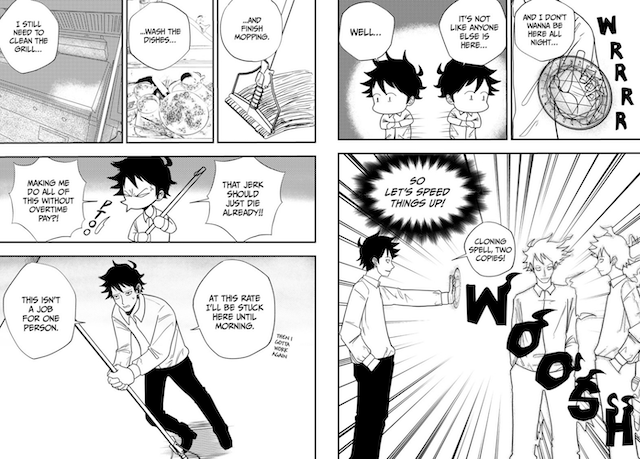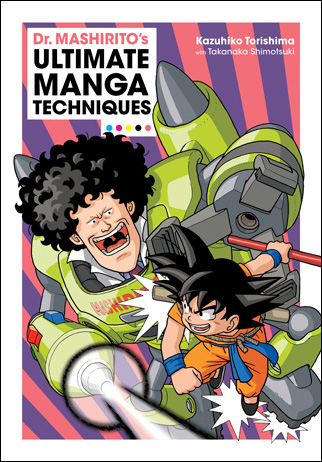Your source for in-depth interviews, manga spotlights, and expert advice for your life as a mangaka.

What could be more important to manga than friends and bonds? This month, VIZ Originals One-shots editor Hisashi SASAKI opens our newsletter by discussing the communication side of creating one-shot manga. “21st Century Witch,” A.E.B’s one-shot, takes the spotlight in a featured interview, and we have even more advice from Kazuhiko Torishima!
CONTENTS:
In Conversation With Manga Editor Hisashi SASAKI
In the Spotlight: “21st Century Witch”
Dr. Mashirito’s Ultimate Manga Techniques: Friends and Bonds
VIZ Originals’ Spooky Season Selections

In our interview this month, VIZ Originals One-shots editor Hisashi SASAKI chats with us about what goes into making a one-shot, from the first promising submission, to the subsequent conversations with the mangaka, to when the one-shot is finally ready to be published.
I’d like to discuss the one-shot development process a bit. After reviewing submissions, selecting a thumbnail, and letting the mangaka know they’ve been selected, what is your first conversation with them like?
Hisashi SASAKI: If I come across an interesting submission, I first contact them via email to express my interest in their work and invite them to a video conference to discuss it further. I prefer direct, immediate communication over email exchanges, and since I’m looking for mangakas instead of individual mangas, I want to get to know them better as people. During the video call, I start by asking what motivated them to create that particular manga. I believe that editors and mangakas should share similar values regarding manga if they want to work as a team.
When delivering feedback, do you prefer to do that via video call over an email? Do you find it’s easier to communicate revisions or issues over video?
SASAKI: I definitely prefer a video call, but ideally we meet in person! Emails are too permanent and blunt, and I treasure live conversations with mangakas.
How do you recognize when a one-shot manga is done, appropriate to the platform, and ready for release?
SASAKI: I first review whether or not a manga is being improved through its revisions. If the mangaka is revising it against their will, only because their editors insist, then I don’t consider it an improvement. The mangaka must genuinely believe that the manga is being improved through revisions. In essence, I must ensure that the editors and the mangakas are on the same page, moving in the same direction together. There’s no specific end to the revision process; we simply continue revising it (or discard it to start working on new projects) until the mangakas and editors agree that it’s ready for publication.
Making sure that mangakas and editors are moving in the same direction is a great point. What kind of things do you value in mangaka?
SASAKI: I love meeting a mangaka who truly LOVES their characters.
If you and a mangaka are not on the same page, is there a solution? Is it better for the editor to adopt the mangaka’s position in this case, or for the mangaka to work with another editor?
SASAKI: Editors are expected to have broader perspectives than mangakas and should generally adopt the mangakas’ positions. However, there is a limit to the breadth of perspectives each editor can possess. Therefore, I believe it is beneficial for mangakas to work with publishers. Most publishers, including VIZ, have a team of editors. If an editor feels that a particular manga is good but falls outside their expertise, they can consult with their colleagues and delegate it to other editors with different perspectives.

VIZ Originals One-shots editor Hisashi SASAKI explained what first caught his eye with “21st Century Witch”, by the mangaka A.E.B, “The biggest thing I look out for is not a perfect, finished piece, but one that holds the shining promise of something more.” A.E.B’s work delivers on that promise, with strong character work and a magic system that’s funny—and maybe even a little down-to-earth. We spoke to A.E.B about “21st Century Witch” and curses!
Watching a relationship grow between characters is a particularly pleasant thing in manga, and you’ve built a one-shot around that idea, in part. What appeals to you about stories like this?
A.E.B: Definitely the back and forth between characters. I’ve always enjoyed when manga artists would show their characters getting to know each other and bonding, which in turn, strengthens their relationships.
Adam lives a careful life, making sure not to reveal his magical secret. Marline, on the other hand, has secrets of her own but carries herself with much more freedom. What makes Marline seem better adjusted than Adam? What’s behind their difference in perspectives?
A.E.B: Funny enough, back when Marline was a witch hunter, she was quite stoic and merciless. But as she aged and centuries flew by, her adventures and the people she met mellowed her out, as she stopped taking life so seriously. There’s also the fact that she’s aware no one would believe her even if she revealed her secret. If she went up to someone and said, “Hey, I’m actually over a thousand years old!”, everyone would think she’s either insane or a jokester. As her goal is to find a witch to remove her curse, she doesn’t believe there’s a need to reveal her secret to regular people who wouldn’t understand or believe her.
As for Adam, his case is a bit more simple. He’s seen plenty of movies where the government experiments on supernatural humans and is well aware that he could be in that situation as well. His fear is what primarily keeps him from revealing his secrets, not to mention the laws enforced by witch society, but more so his fear.
I loved the bit about magic being just slightly convenient. Is there any upside to being a witch in this world?
A.E.B: Of course there is! For example, let’s say you locked yourself outside of your house. Instead of having to call a locksmith and deal with all the hassle that comes after, you could just use magic to teleport back inside! Another example is a spell that wasn’t showcased in the one-shot: the flavor spell. It’s quite popular among witches who are parents. Usually when their children make a fuss over eating vegetables, they cast this spell to make the vegetables taste like candy. The kids eat them and ask for seconds while the vegetables keep their nutritional value! It’s a win for both the parents and the kids. And there’s also the can’t-miss spell. A young witch on their school’s basketball team used this spell to make a game-winning full court shot. Usually this would be considered as cheating, but who would know other than the witch? I could sit here all day and talk about the different spells witches use in the modern era, but I feel no one has time to hear me ramble on about that, ha ha.
The Jenga tower metaphor for the curse is really deft, a cool way to explain the idea in an easily understandable bite. While it’s not really the point of the one-shot, can you share anything about how the magical society survives in the shadows? Do they learn magic together, or does it come innately?
A.E.B: I’d love to share! Unbeknownst to the rest of the world, witches have bi-yearly social gatherings in locations that can only be reached by using magic. Despite being an event that allows witches to relax and let loose, it’s more so a matchmaking fest to allow witches to find their potential partner. While some witches might find love with regular people, most prefer to stay with other witches, as they wouldn’t have to keep a secret from their partner. When it comes to learning magic, it’s the duty of the parents to teach their children. Unlike regular children, magical energy begins to grow in witch children around the age of four. The energy itself can’t do anything, as it’s only after parents teach their children spells that they’re able to use it. Parents are aware that children are quite unpredictable, so they cast a child lock spell at birth. A spell that lasts eighteen years and allows parents to seal and unseal their child’s magical energy whenever they please, allowing them to send their children to regular schools without worry of the child outing themselves as a witch. Though some parents allow their children to use magic in school, they’re looked down upon by other witches. In the case where a witch is discovered by a regular civilian, the memory wiping spell is used.
Congratulations on your one-shot! Is there anything else you’d like to say to your readers?
A.E.B: Thank you all for reading my work. It means a lot to me knowing people enjoyed the story. Please look forward to my next one-shot!!

“Even if a character is plain and unremarkable, you can give them traits using their relationships with their friends and allies. For example, if someone who was thought to be a background character actually ended up being related to the protagonist or was the prince of some country, their impression among readers would dramatically change. Plus, if their relatives or that country is part of a special group, any characters that belong to that group will also be elevated to special status. A good example from history would be the Shinsengumi, a group made up entirely of outstanding swordsmen, which continues to be popular to this date. A special group like that can promote the Shinsengumi itself and it can promote the individual members who belong to it, such as Hijikata Toshizo or Okita Soji. In addition, their relationships deepening and forming bonds that connect the characters to one another provides the basis for human drama rich in love and hate to unfold. It’s only natural that the characters in those relationships are more appealing. Also, a relationship with an ally clarifies where a character stands without needing an explanation. For example, if a character is the eldest son in a family, then he would be someone who feels a strong sense of responsibility to protect his other siblings, or something in that vein. The benefits of human relationships when it comes to creating characters are immeasurable. ”
—Kazuhiko Torishima (Dr. Mashirito’s Ultimate Manga Techniques, page 39)
Betwixt (Available Now!)
Devil’s Candy (Available Now!)
I’m The Grim Reaper, volume 4
(November 2025)
Sign up here to get the latest VIZ Originals Creator Newsletter straight to your email!
Already have a VIZ account? Log in.
Don't have an account? Sign up.
Enter the e-mail address associated with your account and we'll email you a link to reset your password.